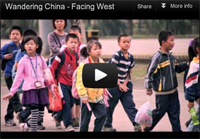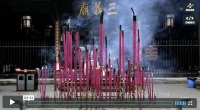
And here comes a cab speeding through. Do notice the green man circled in the background. Mind you these automobiles are coming from directly opposite, i.e. rushing through from a red light.
A country as vast as China is bound to have a fair share of good and bad. On many fronts, China have begun to lead the way in terms of economic management and green technology, but in terms of a civil society, there is one observable gap. Here is a focus on the that gap.
It may be a narrow measure, but my encounters at traffic crossings here have tended to be rather ‘challenging’. Automobiles usually refuse to give pedestrians right of way here even when the green man flashes. Buses are pretty obvious culprits, and so are taxis, all manner of cars, motorbikes and bicycles. It was not so bad in Shanghai, but here in Beijing, it is almost paralyzing as every instance of road-crossing is a minor dance with potential collision. I would say it on par with my earlier visit to second-tier city Shantou.
I may be used to largely pedestrian-respecting traffic conditions growing up in Singapore and in Australia, but having visited several third-world countries in South-East Asia I have learnt (and advised umpteenth times by my parents) to accept that local conditions are local conditions; and adaptability is the wiser thing to do. However, looking at the grand buildings and wide roads in Beijing, there was a huge cognitive dissonance when I almost got run over crossing the road a few times over the past few days.

Here comes a Volkswagen speeding through the pedestrian green light. How was I ever to be able to cross?
Here typically, pedestrians get horned at and pressured even when the green man is on in their favour; in the presence of traffic wardens. The bulk of the pedestrians do not seem to mind – but being a visitor, I did, initially. I would imagine most tourists would. Perhaps this is a third-world remnant of China’s progress and many will say that it has improved, but few Chinese argue back when this is mentioned to them – how civil can one be when car owners continue to harass and threaten to run pedestrians over at zebra and pedestrian crossings?
Locals argue in return stating there are simply too many pedestrians to let them all pass (Beijing City is chock-full of people at 16 million, almost as many as the entire country of Australia), and I can see why – traffic here can be worse than compressed sardines in a tin. Nevertheless, the simple fact remains – driving in a way that potentially runs over pedestrians is far from civil. Here is some more photographic evidence taken early this morning.

A van this time prevents me from crossing safely. This was about 9.30am past peak hour. I will endeavour to get some peak hour photos for a better sense of how intense it gets.

A bigger van this time.

Despite it all, the Chinese have good civic mindedness on board public transport. Everyone on board a bus I took gave up their seats for the elderly.
Filed under: China Trip 2010






















The Sharing Circle